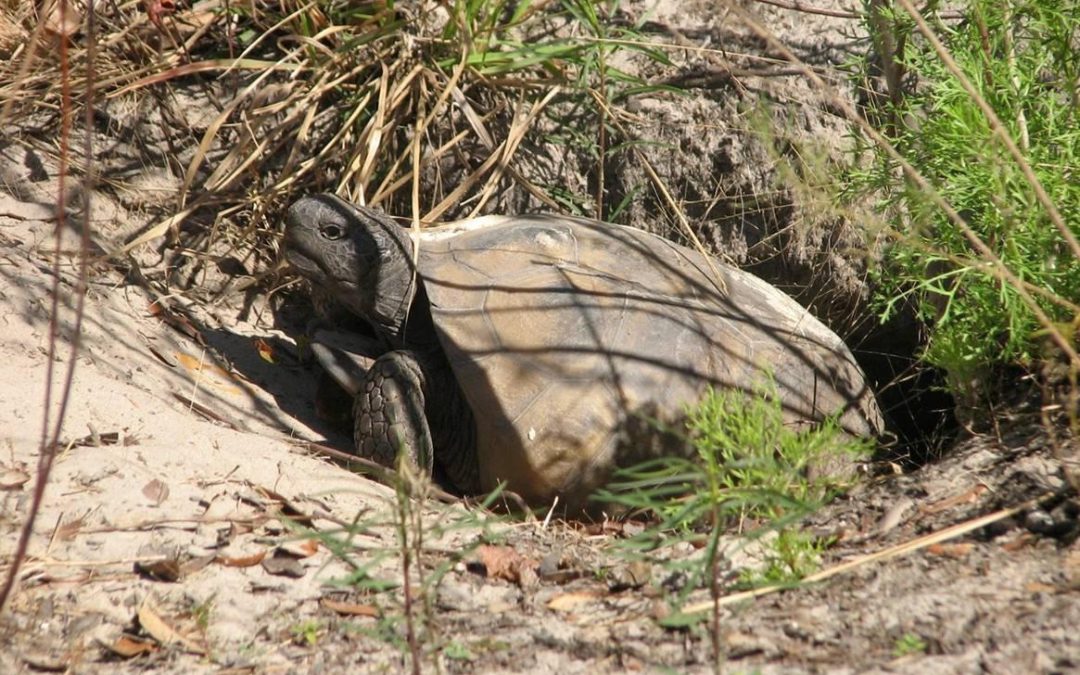
by Rick O'Connor | Jul 16, 2020
This blog will wrap up our series on Florida turtles for the Year of the Turtle (2020) – and we end with a good one – the gopher tortoise. We only have two true terrestrial species of turtles in Florida, and it does not get more terrestrial than the gopher tortoise.
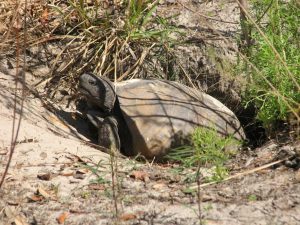
Gopher tortoises are long-lived, protected by their thick shells and deep burrows. Photo credit: Carrie Stevenson, UF IFAS Extension
“Gophers” (Gopherus polyphemus) are well known to many ole timers because they like the same type of habitat the earlier settlers did – high dry ground. They are indigenous to the southeast United States and prefer the open canopy of pine forest habitat. As a kid our home was on such a place in an area of Pensacola called Scenic Heights. Our house was on a “sand hill” that had pine and turkey oak trees. There were a variety of grasses and legumes growing everywhere and the soil was very dry and sandy. And we had gopher tortoise. The famous 18th century traveler/botanist, William Bartram, described this animal several times during his travels across the southeast as he crossed “sand hills” within the massive expanse of pine forest that were here at that time.
Though a forest, the longleaf pine forest of the southeast had a more open canopy allowing the growth of a variety of grasses to do well on the forest floor – as they did at my house. Tortoises are vegetarians, eating a variety of these grasses, flowers, and ground fruit. They like the young tender shoots of these plants and they were maintained those decades ago by natural wildfires started by lighting. The small fires would burn the large, tough plants down, providing the young tender shoots the tortoises prefer.
If you see a tortoise, you will notice the large square shaped shell and the elephant-like feet – definitely not a water turtle. They dig burrows in this sandy soil in which they can live during the hot days of summer and the cold days of winter. These burrows can be quite extensive – reaching a length of over 15 feet and a depth of up to 7 feet from the surface. Though the literature will tell you that they prefer dry sandy soils for digging, they have been found digging in the red clay of the southeast as well. However, these burrows are generally not as deep because the O2 levels decline and the CO2 concentrations increase significantly in clay soils. There is only one entrance to the burrow, and it has been said that gophers can dig down – but not up.

Gopher tortoises are nesting right now–be sure to observe from a distance!
It is generally one tortoise to a burrow, but some will dig a second burrow within their range as a “back-up” during pop up thunderstorms and such. It is not uncommon to find 2-3 tortoises sharing he entrance of a burrow during stressful moments – or during mating of course. The temperatures within are nice a cool during the summer – ranging from 60 – 72°F. This “air conditioned” hide away has become popular with many other creatures of the pine forest. Over 350 species of them have been known to share the burrow. Most of these are insects but a few vertebrates are known to call including – the gopher frog, mice, the endangered eastern indigo snake, and the eastern diamondback rattlesnake. Most of these animals use the burrow during extreme conditions – heavy rain, intense heat or cold, or during a forest fire. The rattlesnakes tend to sit near the entrance and so observers should beware of sticking their face or hand into the opening looking for a turtle. Many field workers will use a small hand mirror to look into the opening. Either you see the rattlesnake, or, the reflection of sunlight into the burrow will cause the snake to rattle – altering you they are there.
Terrestrial turtles produce fewer young than aquatic species. Gophers will typically produce 5-9 eggs once a year. The eggs are usually buried within the “apron” of the burrow – this is the field of sand discarded while digging. There is a projection from the anterior end of the plastron called a gular. This projection is much longer in males and can be used in jousting matches with other males. Males will also have a concave depression from the midpoint to the posterior end of the plastron. Though mating can occur any time of year – most activity is from May to July.
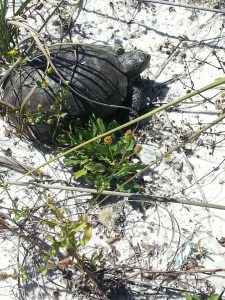
A terrestrial gopher tortoise crossing the sand on Pensacola Beach.
Photo: DJ Zemenick
These animals have declined across their range. They have the typical turtle egg raiders (raccoons, fox, skunks, and opossums) but now have threats from invasive species such as tegus and fire ants. Hatchlings and juveniles have soft shells and are easy targets. Coyotes have been seen hiding behind burrows flipping the emerging tortoise and then consuming it. However, man has been a problem as well.
Food was one problem, and apparently still is in some parts of the south. These animals were “noosed” from their burrows and cooked. During the depression era they were known as “Hoover’s Chicken”. As mentioned at the beginning – they live where we want to live. Construction crews come in and cover “entomb” them during development projects. It is now against Florida law and crews must relocate them.
In natural areas, the suppression of natural wildfires as altered the ecology enough that food for the gophers has become an issue. As they abandon their burrows seeking better spots, they are preyed upon, run over by cars, attacked by dogs, the list goes on. In recent years, an upper respiratory tract disease has proven to be common and deadly.
Today the animal is federally protected in Louisiana, Mississippi, and western Alabama. It is species of concern throughout its range and is a state threatened species in Florida. You cannot possess this animal but having one move into your yard is fine.
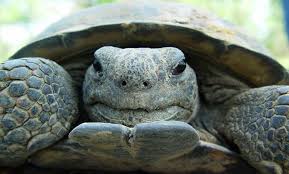
This gopher tortoise was found in a dune field; a place where they have historically been found.
Photo: DJ Zemenick
I hope you enjoyed this series on Florida turtles, during the YEAR OF THE TURTLE. You can find more blogs on other species by visiting the natural resource page of the Escambia County Extension website and type in which species you are looking for in the “what can we help you with?” search tool at the top of the page. https://sfyl.ifas.ufl.edu/escambia/?topic=natural-resources#county-feed.
I hope you are lucky enough to find all 25 species in the wild.

by Carrie Stevenson | May 8, 2020

In ecology, a “keystone” species is as crucial to an ecosystem as the central stone in this arch.
In architecture, a “keystone” is the top, central block in an arch structure, the one that holds the entire building up. Without it, the bricks around it collapse. With it, there is nothing stronger.
So, when you hear an animal referred to as a “keystone” species, it should get your attention—especially when that species is listed as threatened by state and federal wildlife agencies. In northwest Florida, one of the species upon which the entire longleaf ecosystem is built is the humble gopher tortoise (Gopherus polyphemus).

Gopher tortoises are long-lived, protected by their thick shells and deep burrows. Photo credit: Carrie Stevenson, UF IFAS Extension
Once hunted for food and currently in competition with humans for buildable land, this long-lived reptile is an architect in its own right. The tortoises are called “gophers” because of their tunnel building and burrow construction expertise. The tortoises spend about 80% of their time near their burrows, of which they have multiple over their lifetimes. Being a cold-blooded reptile, the burrows allow the tortoises a place to live in the temperature-regulated soil.
The average adult gopher tortoise is about 9-11 inches long, although they can be larger. They have thick feet resembling those of an elephant, and scaly front legs used for digging and burrowing. They are tan, brown, or gray, and live in dry, sandy, upland habitats. Their propensity for dry forestland is typically why their populations are in peril, as this is also the best land for building and development.
The average gopher tortoise’s burrow is 6.5 feet deep and 15-40 feet long, and provides habitat for 350 other species! Those commensal species that share its burrow are mostly invertebrates, but at least 50 are larger backboned species like frogs, snakes, rabbits, and burrowing owls. During forest fires, there are stories of multiple species—from deer and snakes and turtles—calling a truce and hiding in the burrows together until the flames blow over.

Gopher tortoises are nesting right now–be sure to observe from a distance!
Right now—from May to July—is nesting season for gopher tortoises. They lay eggs in the soft sand of their burrow apron, which is the triangular spread of loose sand at the opening of the burrow. Eggs incubate all summer and emerge between August and November. The newly hatched tortoises can expect to live 40 to 60 years in the wild. They live on a variety of grasses and low-growing plants native to longleaf pine, oak forests, and coastal dunes, including wiregrass and gopher apple. They are adapted to routine fires, as they are safe in their burrows and the new growth after a burn provides an abundance of their grassy food sources.

by Rick O'Connor | Jun 22, 2018
Just a decade ago, few people would have known what a gopher tortoise was and would have hard time finding one. But today, because of the protection they have been afforded by the state, they are becoming more common. This is certainly an animal you might see visiting one of our state parks.
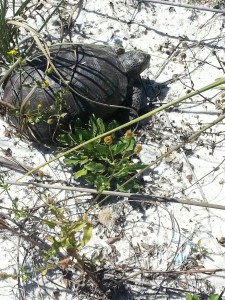
This gopher tortoise was found in the dune fields on a barrier island – an area where they were once found.
Photo: DJ Zemenick
The gopher tortoise is one of only two true land dwelling turtles in our area and is in a family all to its own. They are miners, digging large burrows that can extend up to a depth of 7 feet and a length of 15 feet underground. However, tortoises are not very good at digging up towards the surface, so there is only the one entrance in and out of the burrow. The burrow of the tortoise can be distinguished from other burrowing animals, such as armadillos, in that the bottom line of the opening is flat – a straight line – and the top is domed or arched shaped; mammalian burrows are typically round – circular. Tortoise burrows also possess a layer of dirt tossed in a delta-shaped fan out away from the entrance (called an apron). Many times the soil is from deeper in the ground and has a different color than the soil at the surface. The general rule is one burrow equals one tortoise, though this is not always true. Some burrows are, at times, shared by more than one and some may not be occupied at all. Many field biologists will multiple the number of burrows by 0.6 to get an estimate of how many tortoises there are in the area.
The tortoise itself is rather large, shell lengths reaching 15 inches. They can be distinguished from the other land dwelling turtle, the box turtle, by having a more flattened dome to the shell and large elephant like legs. The forelimbs are more muscular than the hind and possess large claws for digging the burrow. They are much larger than box turtles and do not have hinged plastrons (the shell covering the chest area) and cannot close themselves up within the shell as box turtles can. Tortoises prefer dry sandy soils in areas where it is more open and there are plenty of young plants to eat; box turtles are fans of more dense brush and wooded areas.
Tortoises spend most of the day within their burrows – which remain in the 70°F range. Usually when it is cooler, early morning or late afternoon, or during a rain event – the tortoises will emerge and feed on young plants. You can see the paths they take from their burrows on foraging trips. They feed on different types of plants during different type times of the year to obtain the specific nutrients. There are few predators who can get through the tough shell, but they do have some and so do not remain out for very long. Most people find their burrows, and not the tortoise. You can tell if the burrow has an active tortoise within by the tracks and scrap marks at the entrance. Active burrows are “clean” and not overgrown with weeds and debris. Many times, you can see the face of the tortoise at the entrance, but once they detect you – they will retreat further down. Many times a photo shot within a burrow will reveal the face of a tortoise in the picture. There is a warning here though. Over 370 species of creatures use this burrow to get out of the weather along with the tortoise – one of them is the diamondback rattlesnake. So do not stick your hand or your face into the entrance seeking a tortoise.
Most of the creatures sharing the burrow are insects but there are others such as the gopher frog and the gopher mouse. One interesting member of the burrow family is the Eastern Indigo Snake. This is the largest native snake to North America, reaching a length of eight feet, and is a beautiful iridescent black color. It is often confused with the Southern Black Racer. However, the black racer is not as long, not as large around (girth), and possess a white lower jaw instead of the red-orange colored one of the indigo. The indigo is not dangerous at all, actually it feeds on venomous snakes and it is a good one to have around.
Federal and state laws protect the indigo, as with the gopher frog and mouse. All of these animals have declined in number over the past few decades. This is primarily due to loss of the needed gopher burrows, which have declined because the tortoises have declined, and this is due to habitat loss and harvesting. Again, tortoises like dry sandy soils for digging burrows. They prefer wooded areas that are more open and allow the sun to reach the forest floor where young grasses and flowers can grow. The longleaf pine forest is historically the place to find them but they are found in coastal areas where such open wooded areas exist. The lack of prescribe burning has been a problem for them. Florida is the number one state for lightning strikes. Historically, lightning strikes would occasionally start fires, which would burn the underbrush and allow grasses to grow. In recent years, humans have suppressed such fires, for obvious reasons, and the tortoise community has suffered because of it. Therefore, we now have prescribe fire programs on most public lands in the area. This has helped to increase the number of tortoises in the area and your chance of seeing one.
All of the members of the tortoise community are still protected by state, and – in the case of the indigo snake – federal law, so you must not disturb them if seen. Photos are great and you should feel lucky to have viewed one. Though they could be found anywhere where it is high, dry, and somewhat open – the state and national parks are good places to look.
Reference
Meylan, P.A. (Ed.). 2006. Biology and Conservation of Florida Turtles. Chelonian Research Monographs No. 3, 376 pp.

by Rick O'Connor | Apr 8, 2016

This gopher tortoise was found in the dune fields on a barrier island – an area where they were once found.
Photo: DJ Zemenick
The state of Florida has designated Sunday April 10 as “Gopher Tortoise Day”. The objective is to bring awareness to this declining species and, hopefully, an interest in protecting it.
During his travels across the southeast in the late 18th century, William Bartram mentioned this creature several times. As he walked through miles of open longleaf pine he would climb sand hills where he often encountered the tortoise. These turtles do like high dry sandy habitats. Here they dig their famous burrows into the earth.
These burrows can extend almost 10 feet vertically below the surface but, being excavated at an angle, can extend 20 feet in length. There is only one entrance and the tortoise works hard to maintain it. Field biologists have been able to identify over 370 species of upland creatures that utilize these burrows as refuge either for short or long periods of time. These include the declining diamondback rattlesnakes, gopher frogs, and the endangered indigo snakes, but most are insects and small mammals. Because of the importance of the burrows to these species, gopher tortoises are listed as keystone species – meaning their decline will trigger the decline of the others and can upset the balance of the ecosystem. Gopher burrows can be distinguished from mammal burrows in that they are domed across the top but flat along the bottom, as opposed to being oval. The width of the burrow is close to the length of the tortoise. When danger is encountered the tortoise will turn sideways – effectively blocking the entire entrance. Though there are cases of multiple tortoises in one, the general rule is one tortoise per burrow.
Tortoises are herbivores, feeding on a variety of young herbaceous shoots, and fruit when they can get find them. Fire is important to the longleaf system and it is important to the gophers as well. Fires encourage new young shoots to sprout. If an area does not receive sufficient fire, and the ground vegetation allowed grow larger with tougher leaves, the tortoise will abandon their burrow and seek more suitable habitat – which, especially in Florida – is becoming harder and harder to find. They typically breed in the fall and will lay their 5-10 eggs in the loose sand near the entrance of the burrow in spring. In August the hatchlings emerge and may hide beneath leaf litter, but will quickly begin their own burrows.
This tortoise is only found in the southeast of the United States and it is in decline across the region. They are currently listed as threatened in Florida but are federally protected in Louisiana, Mississippi, and western Alabama. They are found across our state as far south as the Everglades. There are several reasons why their numbers have declined. Human consumption was common in the early parts of the 20th century, and still is in some locations – though illegal. Some would, at times, pour gasoline down the burrow to capture rattlesnakes – this of course did not fare well for the tortoise. A big problem is the loss of suitable habitat. Much of upland systems require periodic fires to maintain the reproductive cycle of community members. The suppression of fire has caused the decline of many species in our state including gopher tortoises. These under maintained forest have forced tortoises to roadsides, power line fields, airports, and pastures. In each case they have encountered humans with cars, lawn mowers, and heavy equipment. Keep in mind also that our growing population is forcing us to clear much of these upland habitats for developments where clearing has caused the burial (entombment) of many burrows.
This is a unique turtle to our region and honestly, is a pleasure to see. We hope you will take the time to learn more about them by visiting FWC’s Gopher Tortoise Day website, enjoy watching them if they live near you, and help us conserve this species for future generations.







